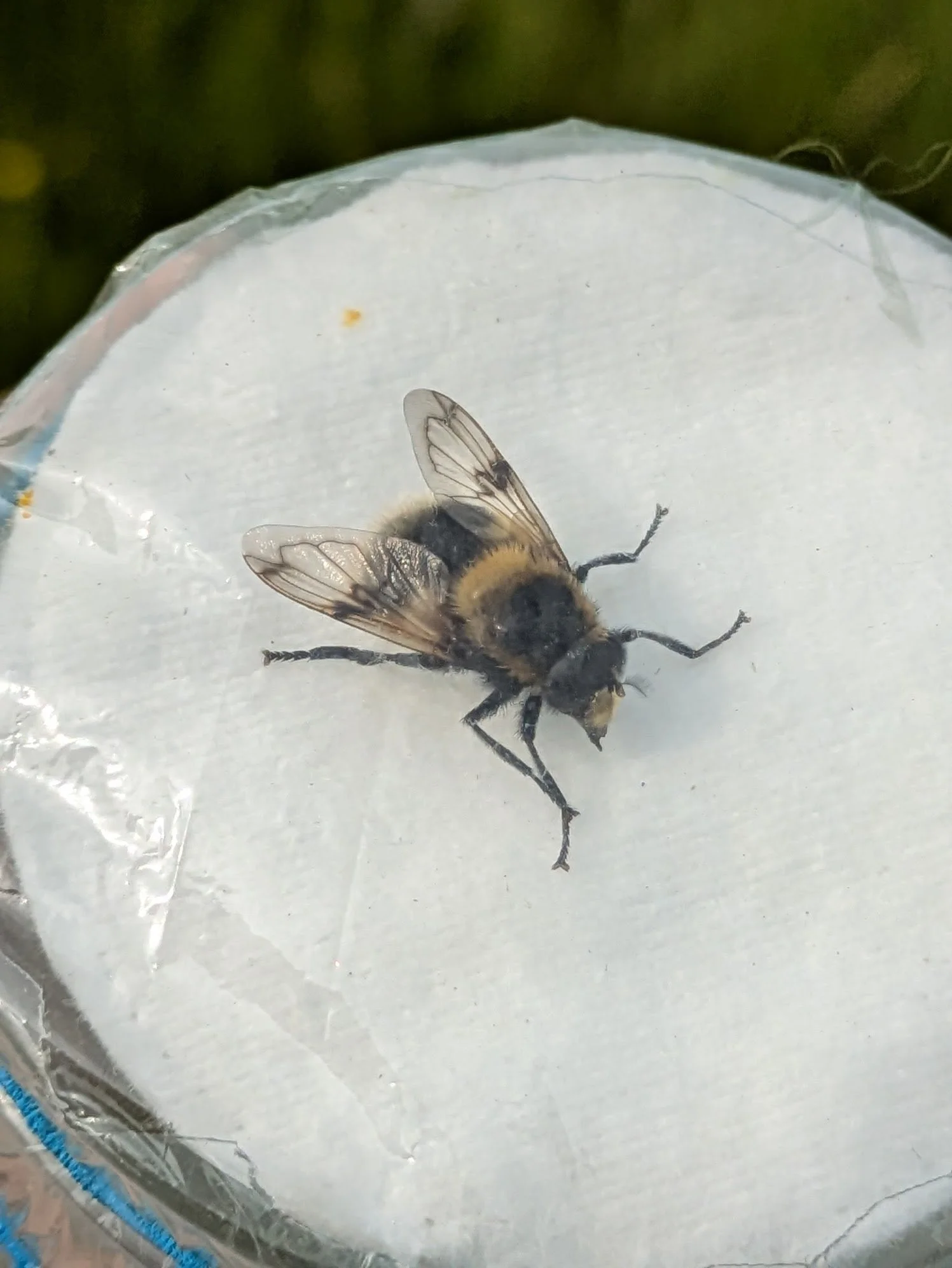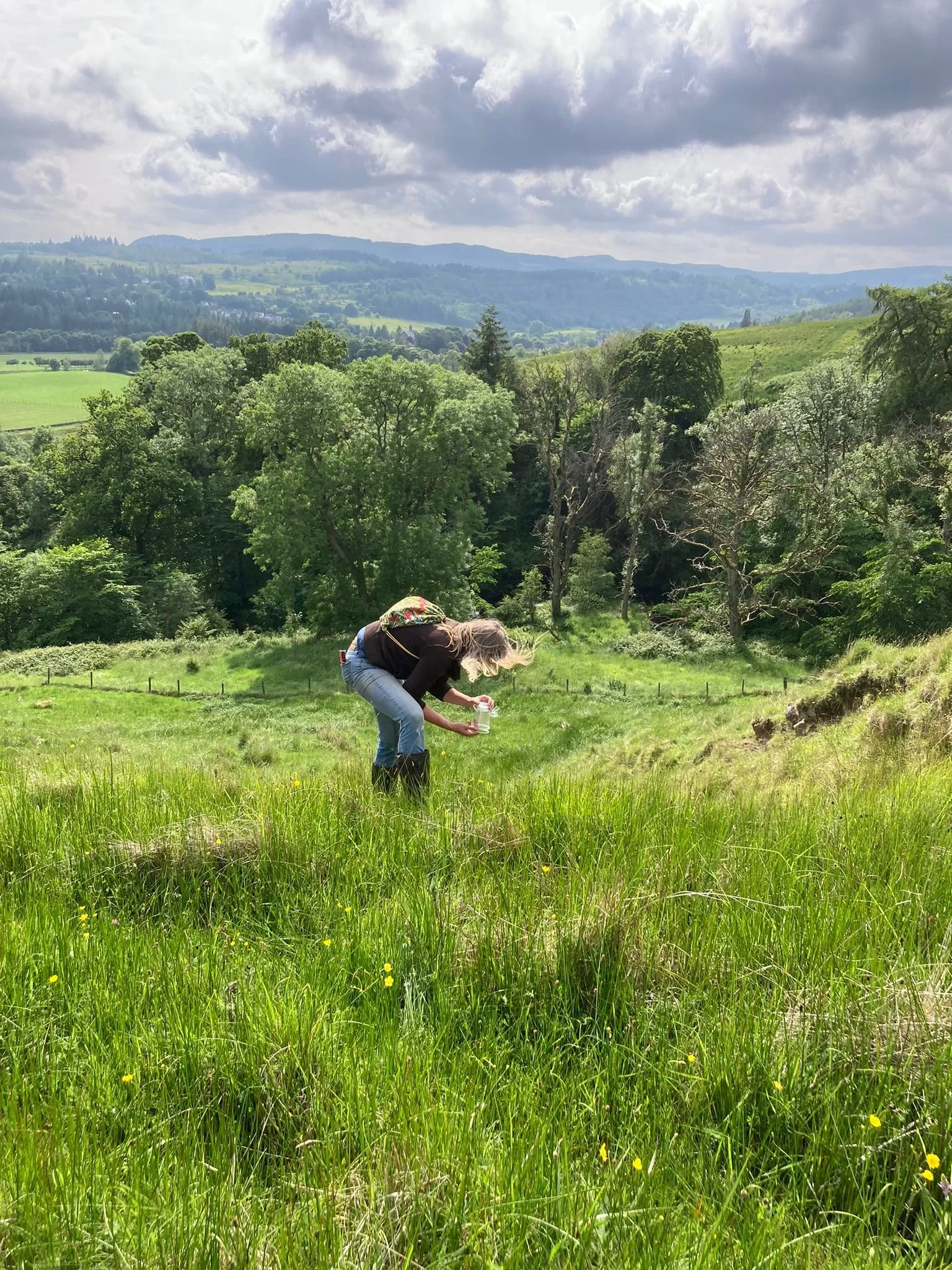
Bumblebee Identification, 2025
By Mirte Greve
Background photograph © Mirte Greve
Boosting local bumblebee identification knowledge in Stirlingshire
Through the BRISC/GNHS Bursary, I was able to attend the Bumblebee Identification course organised by the Field Studies Council which has greatly boosted my knowledge and skills of field identification of bumblebees.
To further local conservation in the Strathblane area, I have been identifying and recording a wide range of species. The species found thus far, indicate that areas on the south slopes of the Campsie Hills are of special ecological interest. They comprise in a combination of woodland patches, a mosaic of long-established unimproved acidic, neutral and calcareous grasslands, moorland and blanket bog further uphill. Insect species populations previously unrecorded in the area, including the Spotted cuckoo spider wasp, Narrow-bordered five-spot burnet moth, Hemp agrimony plume moth, Pectinate click beetle, Lesser-streaked dung beetle, Bellflower blunthorn bee and Bilberry bumblebee, raise the question which other species can be found here that may be relevant for future conservation efforts. Because all data collected must be reliable and verifiable, I wanted to extend my knowledge on bumblebees to add this species group to the ongoing recording efforts by local citizen science groups. As committee member of the Strathblane Wildlife Sanctuary and board member of the Strathblane Community Development Trust, I am involved in various nature creation, conservation and education activities in the village, including planting bee-friendly shrubs and wildflowers, building bee hotels and other bee habitat and organising educational events at the Strathblane Primary School and Strathblane Wildlife Sanctuary site.
The online Bumblebee identification course was spread out over 4 weeks with a weekly online live webinar, study material, quizzes and assignments. The course aims to teach identification skills to reliably identify UK bumblebee species in the field and actively promotes the submission of data to recording schemes so that data can be used for population research and conservation. The subjects covered were an introduction into bumblebee ecology and ecology and field skills, identification of ‘the big 8’ bumblebee species, cuckoo bee identification and an introduction to the rarer UK bumblebee species.
What stood out in the course was the knowledge and enthusiasm of the tutor, Will Hawkes. His PhD focussed on insect migration, and he is a keen bee recorder, radio presenter (Wild Talks, Source FM) and recently started a new job at BugLife as conservation assistant. He offered in-depth answers to all of our questions and created a lovely positive learning space for the group of students with various backgrounds.
Bumblebee ecology
One of the fun first things to learn about bumblebees is that a lot of the species that look like bumblebees are in fact mimics of bees. These include (hover)flies, beetles and even moths. How to tell them apart? Easy once you know: bees always have four wings, long antennae, restricted waists and smaller ‘compound’ eyes. The mimics can look convincing, such as the species Volucella bombylans found near my garden (photo 1) which comes in several subspecies, each mimicking specific bumblebee species, using their ‘bee-look’ to deter predators. These, and some other mimics, have an intricate relationship with bee species and a unique role in the ecosystem. One of the challenges in identifying bees is the speed at which they move, and the detail needed to make a reliable ID for certain species. Will shared a good trick for that: he catches the bees using an insect net and then holds them between two sheets of cellophane, like the wrappings of birthday cards etc. So far, I have been using a 2-cup system with a top of cellophane to catch insects off flowers (see photo 2) but I will try this method too.
Bee mimic Volucella bombylans f. plumata © Mirte Greve
Gypsy cuckoo bee (male), Bombus bohemicus, showing the typical tank-like appearance, yellow patch above the white band on the abdomen and darkened wings. © Mirte Greve
Forest cuckoo bee (male), Bombus sylvestris, showing its typical red fluff at the end of its abdomen © Mirte Greve
‘Beehunting’ at the Ballagan waxcap grasslands using two cups to trap and release © Mirte Greve
The big 8
We started out learning to identify the ‘Big 8’ most common species, namely Buff-tailed-, White-tailed-, Garden-, Heath-, Early-, Tree and Red-tailed bumblebee and Common carder bee. You’d think it would be easy to tell ‘just’ the 8 most abundant species of bumblebee apart, but some need some close-up inspection to determine the species.
Cuckoo bumblebees
Bumblebees have several brood parasites, among which are cuckoo bumblebee species. These species have abandoned nest-building and use the strategy of exploitation of active social bumblebee nests. As they put the host species’ workers to work, they do not produce their own workers. There are 6 species of cuckoo bumblebee found in the UK, of which I was able to locally identify and record two during the course (photo 3-4). The cuckoo bumblebees each have specific species of social bumblebees which they target, and they use both visual and chemical mimicry to enter the bee nests unnoticed. The way to tell them apart from the social bumblebees is by their hairy legs, dark coloured wings and longer abdomens. As they don’t need to carry any pollen, the females lack the pollen baskets called corbicula. They tend to look rather large and robust and more sparsely haired compared to their target species. Apparently, they have a thicker exoskeleton, larger jaws and a stronger stinger, all the tools needed for a bumblebee nest coup!
Rare bumblebees
Although Scotland lacks known populations of several of the rarer bumblebee species, it is always good to keep an eye out for them as remnant populations and climate change influx individuals can sometimes be found. Of particular interest here in Scotland are the Broken-belted bumblebees. Other rare bumblebee species to look out for are the Moss carder bee, including the subspecies Bombus muscorum spp. agricolae, the Great yellow bumblebee and the Bilberry bumblebee. The Bilberry bumblebees can be found on the Campsie hills, among the heather and bilberry. They are unmistakable with more than two-thirds of their abdomen covered in orange/red hairs.
Conclusion
I would highly recommend anyone interested in learning about bumblebee ecology and recording bumblebees to take the Field Identification of Bumblebee course at the Field Studies Council. I am grateful for BRISC and GNHS for giving me the opportunity to expand my knowledge which I will put to good use, recording local wildlife and educating others at the upcoming bee events at the Strathblane Wildlife Sanctuary.
© Victoria McKinney





